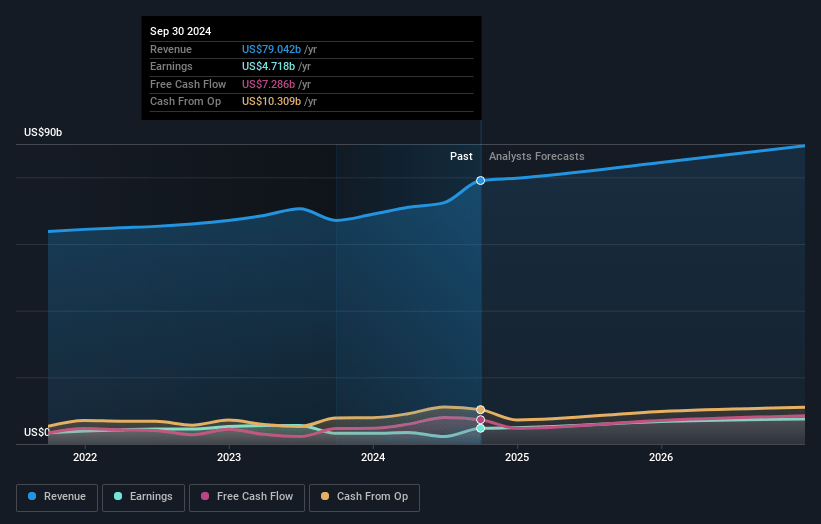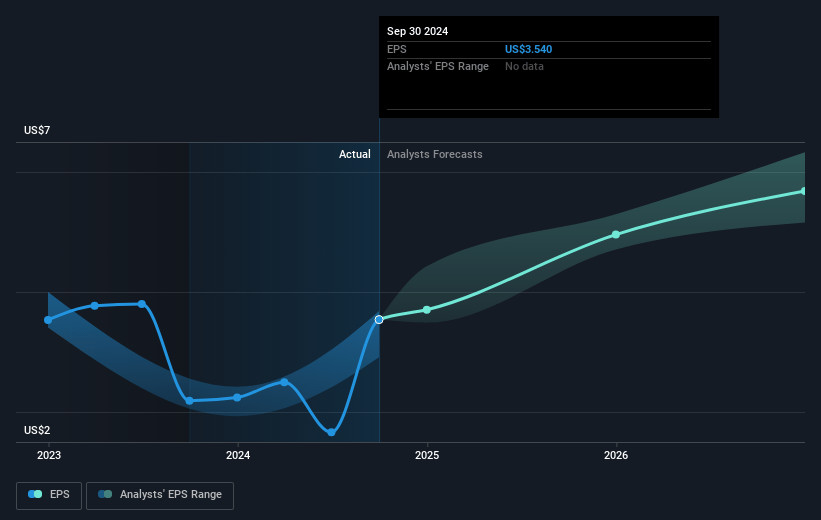Key Takeaways
- Strong organic sales growth and margin expansion support future revenue and profitability through robust operations and innovations like GTF Advantage and LTAMDS.
- Strategic investments in U.S. manufacturing and alignment with global defense budgets enhance production capabilities, cost efficiencies, and revenue stability.
- Global tariffs, regulatory uncertainties, supply chain challenges, and dependence on defense contracts pose risks to RTX's revenues, net margins, and cash flow stability.
Catalysts
About RTX- An aerospace and defense company, provides systems and services for the commercial, military, and government customers in the United States and internationally.
- RTX is seeing strong organic sales growth and segment margin expansion from its business segments, supported by a robust core operating system, which is likely to positively impact future revenue and margins.
- The GTF program is exhibiting significant MRO output growth, expected to enhance operational efficiency and reduce grounded airplanes, projecting revenue growth from increased aftermarket activities.
- RTX is advancing two future innovations: the GTF Advantage, which will improve engine durability and efficiency, and the LTAMDS, which provides advanced defense capabilities. These innovations are likely catalysts for future revenue growth and margin improvement.
- Significant investments in U.S. manufacturing and supply chain improvements are underway. These investments are expected to secure future production capabilities and leverage cost efficiencies, impacting margins and overall profitability positively.
- The company sees opportunities in increased global defense budgets, particularly in Europe, which align well with its core capabilities. This anticipated demand is likely to strengthen revenue growth and provide a stable backlog for RTX's defense segment.
RTX Future Earnings and Revenue Growth
Assumptions
How have these above catalysts been quantified?- Analysts are assuming RTX's revenue will grow by 5.2% annually over the next 3 years.
- Analysts assume that profit margins will increase from 5.6% today to 8.8% in 3 years time.
- Analysts expect earnings to reach $8.4 billion (and earnings per share of $6.56) by about April 2028, up from $4.6 billion today. However, there is some disagreement amongst the analysts with the more bullish ones expecting earnings as high as $9.3 billion.
- In order for the above numbers to justify the analysts price target, the company would need to trade at a PE ratio of 27.5x on those 2028 earnings, down from 33.0x today. This future PE is lower than the current PE for the US Aerospace & Defense industry at 30.0x.
- Analysts expect the number of shares outstanding to grow by 0.58% per year for the next 3 years.
- To value all of this in today's terms, we will use a discount rate of 6.52%, as per the Simply Wall St company report.
RTX Future Earnings Per Share Growth
Risks
What could happen that would invalidate this narrative?- The potential impact of tariffs from Canada, Mexico, China, and the rest of the world could amount to around $850 million, net of mitigations, affecting RTX's pretax operating profit and creating a cash flow drag due to inventory and duty drawbacks.
- Uncertain regulatory environments, including evolving global trade policies, present risks of operational disruptions and customer reactions that could alter demand, impacting revenue and net margins negatively.
- Supply chain issues, especially with the import of raw materials and parts, could be exacerbated by tariffs, leading to possible production delays and increased costs, which may reduce net margins and earnings.
- RTX's reliance on defense contracts in a challenging procurement environment may lead to timing issues with order conversions, potentially delaying revenue recognition and affecting cash flow and profitability.
- Changes in customer behavior, particularly in the aerospace sector, due to macroeconomic uncertainties or potential recessions, could lead to lower demand for commercial aftermarket and OE sales, thereby affecting revenues and net margins.
Valuation
How have all the factors above been brought together to estimate a fair value?- The analysts have a consensus price target of $140.743 for RTX based on their expectations of its future earnings growth, profit margins and other risk factors. However, there is a degree of disagreement amongst analysts, with the most bullish reporting a price target of $160.0, and the most bearish reporting a price target of just $120.0.
- In order for you to agree with the analyst's consensus, you'd need to believe that by 2028, revenues will be $95.1 billion, earnings will come to $8.4 billion, and it would be trading on a PE ratio of 27.5x, assuming you use a discount rate of 6.5%.
- Given the current share price of $113.75, the analyst price target of $140.74 is 19.2% higher.
- We always encourage you to reach your own conclusions though. So sense check these analyst numbers against your own assumptions and expectations based on your understanding of the business and what you believe is probable.
How well do narratives help inform your perspective?
Disclaimer
Warren A.I. is a tool utilizing a Large Language Model (LLM) that ingests data on consensus price targets, forecasted revenue and earnings figures, as well as the transcripts of earnings calls to produce qualitative analysis. The narratives produced by Warren A.I. are general in nature and are based solely on analyst data and publicly-available material published by the respective companies. These scenarios are not indicative of the company's future performance and are exploratory in nature. Simply Wall St has no position in the company(s) mentioned. Simply Wall St may provide the securities issuer or related entities with website advertising services for a fee, on an arm's length basis. These relationships have no impact on the way we conduct our business, the content we host, or how our content is served to users. The price targets and estimates used are consensus data, and do not constitute a recommendation to buy or sell any stock, and they do not take account of your objectives, or your financial situation. Note that Warren A.I.'s analysis may not factor in the latest price-sensitive company announcements or qualitative material.




